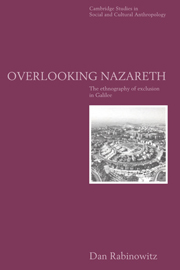Book contents
- Frontmatter
- Contents
- List of maps
- List of tables
- Preface
- Part 1 Bigoted Liberals
- 1 The Ḥaj, the mayor, and the deputy prime minister
- 2 Tale of two cities
- 3 To sell or not to sell
- 4 Differentiated space
- 5 The limits of liberal education
- 6 Reflexivity and liberalism
- Part 2 Resistance?
- Notes
- References
- Index
- Cambridge Studies in Social and Cultural Anthropolgy
1 - The Ḥaj, the mayor, and the deputy prime minister
Published online by Cambridge University Press: 05 October 2010
- Frontmatter
- Contents
- List of maps
- List of tables
- Preface
- Part 1 Bigoted Liberals
- 1 The Ḥaj, the mayor, and the deputy prime minister
- 2 Tale of two cities
- 3 To sell or not to sell
- 4 Differentiated space
- 5 The limits of liberal education
- 6 Reflexivity and liberalism
- Part 2 Resistance?
- Notes
- References
- Index
- Cambridge Studies in Social and Cultural Anthropolgy
Summary
A journey with the Ḥaj
The Haj walks slowly up the hill overlooking the highway which leads into the Israeli new town of Natzerat Illit. Constructed in the 1960s, the modern road and the near-by motor factory lie in a flat section of a little valley, an uncharacteristic feature in this otherwise uneven terrain. It is spring and the rolling hills abound with bloom.
A resident of the adjacent Palestinian town of Nazareth, (al-Naṣira in Arabic) the Ḥaj has not set foot here since his land was seized by the Israeli government in the 1950s, to be annexed to the municipal territory of Natzerat Illit. ‘This bit of level ground’, he tells us, pointing at the factory yard, with rows of brand new military vehicles fresh off the production line, ‘was known as Karm Ṭabariya. Good land. My uncle, who leased it by a Ḍaman arrangement from Yūsūf al-Fahūm's family, used to grow there barley, sesame and wheat.'
Palestinians have individual names for landscape features and agricultural plots. Hill tops, slopes and valley sections, threshing rings and water holes, trees and seasonal puddles carry specific epithets. A map of Nazareth and its environs, surveyed and published by the British in 1930, specifies some of the features which the Ḥaj remembers (see map 1).
Most of the sites, however, have since been transformed. Founded in 1957, the new town of Natzerat Illit now hides the natural shapes and land marks beneath residential compounds, commercial centres, industry. The past existence of Palestinians can hardly be inferred by anybody unfamiliar with the recent history of the terrain.
- Type
- Chapter
- Information
- Overlooking NazarethThe Ethnography of Exclusion in Galilee, pp. 3 - 23Publisher: Cambridge University PressPrint publication year: 1997

